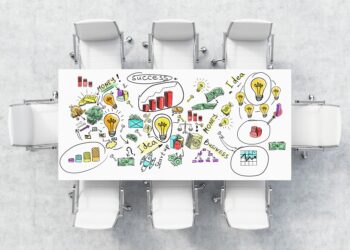Johan Gimenez, Product Owner at Wemanity, supported a French industrial group during the development and upgrading of their website for healthcare professionals. The website facilitates home monitoring of over 1.8 million patients with chronic illnesses. This ambitious product involves several internal brands, therefore it necessitated the participation of a large number of stakeholders. This article addresses the specific challenges of a multi-stakeholder project, the keys to effective organisation, the pitfalls of remote working and the drivers for sustainable engagement of all the stakeholders.
1. Project management: how should you deal with a significant number of stakeholders?
The stakeholders in a project are all those potentially impacted by it. The length of the list can vary depending on the project: the project sponsors, of course, and the project team, end-users, experts who can provide insight, etc.
Rely on the essential ceremonies and tools
Managing lots of stakeholders can be tricky. They each have their own goals, specific priorities, and so on, which can make it difficult to reach a point of agreement. Organisational skills are essential for the product owner(s) orchestrating the project. Johan’s team works, in particular, with the Scrum methodology, which defines four fundamental ceremonies: sprint planning, the daily Scrum, the sprint review and the retrospective.
The meetings that mark the project’s progress provide a very useful framework for getting all the stakeholders on board and ensuring that everyone has access to the same information. Successfully identifying the essential stakeholders to bring on board for a particular meeting is essential.
For Johan, the most important meeting is undoubtedly the sprint review:
“The Sprint Review is a key point for discussion with stakeholders, where we show what we have achieved and where we plan to go next. These fortnightly meetings ensure that we get regular feedback and discuss what is envisioned.”
Johan and his team have established additional synchronisation points with the various stakeholders to keep everyone moving in the same direction.
“These points were developed through co-construction: the stakeholders were involved from the start, which ensured everyone had an overall view of the project.” Being able to rely on “these recurring points is essential. And all the more so at the moment, in a context where unofficial points are far less easy to arrange.”
Important: to ensure nothing is missed, make sure that each stakeholder is represented in the meetings. For complex themes, subjects can be broken down and have a representative by expertise, for example.
Good to know: for Johan, when working on a project with numerous stakeholders, the most valuable tools for the product owner are: - The roadmap: “often complicated to build, especially when there are many stakeholders, but once it’s done, we have our common thread; we know where we are going.” - The backlog: “that’s a bit like your shopping list and is essential for planning. We chose to have a shared backlog with everyone’s priorities visible. It provides a collective overview of the project.”
A good idea: shifting part of the prioritisation to stakeholder level
To minimise possible turf wars, Johan and his team asked the different stakeholders to create an earlier synchronisation point and establish their priorities together, meaning they arrived in front of the project team with a defined need.
The essential thing “to make sure people work without stepping on each other’s toes is to include all the stakeholders. We always discuss things with everyone and not just one stakeholder, then another, etc. In this way, they see each other’s problems and challenges, which helps keep them focused on common goals.”
“For more complex needs, we won’t hesitate to hold additional meetings or informal discussions on different subjects. So we multiply the communication channels, and we work with the stakeholders to help them formalise their needs.”
2. Managing a project with many stakeholders: the challenges of full-time remote working
Since March 2020, remote working has gradually become widespread to the point where it is imposed five days a week in many companies.
On a project with many stakeholders, a Product Owner may find himself faced with unforeseen problems:
- The increasing complexity of onboarding: with the lockdown and health constraints, some stakeholders could not meet the teams physically.
- The difficulty of having “informal” discussions: previously, minor problems could be solved at the coffee machine or during lunch, today in most cases, dedicated points must be planned to address those subjects. “Our calendars look like Christmas trees!” Johan admits.
- Decreased eye contact: Meetings with the participants’ cameras activated are limited. Whether because of technical constraints or for the sake of privacy, meetings often take place in front of black screens or participants’ photos.
To address the new challenges of full remote, Johan tells us that instant messaging has become vital: “We created discussion groups to bring together the different stakeholders, separating the topics for clarity. This doesn’t replace live discussion, of course, but it allows less formal discussion than a meeting.”
Discover our tips for keeping a team working from home motivated.
3. The Product Owner’s challenge: creating engagement with many stakeholders involved
Motivating and engaging multiple stakeholders is a challenge in itself, and even more so nowadays. For Johan, mobilising stakeholders successfully involves three stages.
The first: bringing together people with the right mindset: positive approach, flexibility, desire to collaborate. “Having people in the right state of mind is so important for moving forward together. We were fortunate that all our stakeholders shared this mindset.” But, of course, this is also true for all the other stakeholders in the project, including the product owners, the developers and the Scrum master.
The second is undoubtedly communication and transparency.
“Stakeholders need a common goal if they want to work together successfully. And to work together, they need information. The product owner must really focus on communication and transparency. The stakeholders must feel they are stronger together than alone. We invite stakeholders to all our demos, all our reviews […] Saying we have to be transparent and communicate sounds easy, but it is far from being universal.”
To encourage stakeholder engagement, Johan campaigns for constructive dialogue around achievements and successes… but failures too!
Focus on the unexpected benefits of sharing a failure Johan and his team found themselves in a situation where they had too many things going on in parallel. One part of the development was almost finished, but the other part was not, which blocked the production of the whole, causing a delay of 1 to 2 months in their production cycle. As soon as they recognised the problem, they informed the stakeholders and took action to find solutions. Not only did this ensure that the bond of trust was maintained with the stakeholders, but they realised that some of the needs they expressed were probably not sufficiently well documented. So the stakeholders asked the product team to reject subjects if the need was not sufficiently qualified. Communication and transparency about this failure will have enabled a new stage of maturity to be reached in the relationship between stakeholders and the project team.
Finally, to engage and motivate decision makers, the product owner must be available. “It’s important to be able to respond quickly enough as soon as there are questions.”
“When a new stakeholder arrives, for example, we always give them a short presentation: How does the team work? What is the Scrum method? It is also an opportunity for them to ask us any questions they may have about the organisation of the project.”
His last recommendation: “By being available, by showing that we are successful, but also by not hesitating to recognise failures, by being transparent, and at the same time by bringing together people who all have the right mindset, we manage to develop a climate of trust and a desire to move forward together. It makes you want to do more and give more.”












